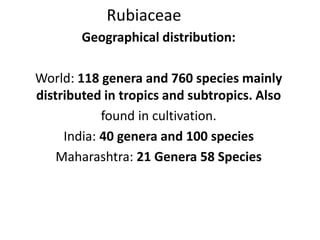
Rubiaceae Family
- 1. Rubiaceae Geographical distribution: World: 118 genera and 760 species mainly distributed in tropics and subtropics. Also found in cultivation. India: 40 genera and 100 species Maharashtra: 21 Genera 58 Species
- 2. Vegetative Characters: Habit: Helophytic, or mesophytic, or xerophytic, or hydrophytic (Limnosipanea). Trees (Neolamarckia, Haldina, Mitragyna) and shrubs (Ixora), or lianas (Oxyceras), or herbs (Neanotis) or climbing (Rubia). Root: Taproot, branched.
- 3. Vegetative Characters: Stem: Aerial, herbaceous, solid. Young stems tetragonal. Plants very commonly characterized with ‘crystal sand’ (calcium oxalate crystals). Armed with prickles (Rubia). Leaves: Leaves simple, opposite, decussate, stipulate; stipules usually leaflike interpetiolar (Ixora). Stomata typically paracytic. Tetragonal stem Interpetiolar stipuleArmed stem
- 4. Reproductive Characters: Inflorescence: Plants usually monoecious, or dioecious (Coprosma). Flowers usually in cymes, or in heads (Neolamarckia, Haldina, Mitragyna Morinda) or solitary (Gardenia). The terminal inflorescence unit cymose. Flower: bractetate, tetracyclic, epigynous, bisexual, pedicellate or sessile, usually actinomorphic, sometimes zygomorphic and bilabiate (Henriquezia). mostly 4–5-merous, often heterostylous. Mytragyna parviflora Adina cordifolia Neolamarckia cadamba
- 5. Calyx: Sepals 4–5, gamosepalous, regular, fused to ovary wall, valvate. Sometimes one of them is enlarged and brightly coloured (Mussaenda) or enlarged in fruit (Nematostylis). Epicalyx present (e.g. Fernelia, Flagenium). Corolla: Petals 4–5, gamopetalous; tubular (Ixora), or hypocrateriform (Pentas) with imbricate, or valvate, or contorted aestivation. Androecium: Stamens as many as petals, epipetalous or attached at its very base in (Coprosma); opposite to sepals or alternating with petals, polyandrous. Anthers dithecous, tetrasporangiate, introrse. Pollen mostly shed as single grains or in tetrads (Gardenia). Mussaenda Tetrasporangiate anthers
- 6. Reproductive Characters: Gynoecium: 2–many carpellary, syncarpus, always inferior, or semi-inferior (Synaptanthera), unilocular (Gardenia), or bilocular (Plectronia) or pentalocular (Meyenia) with 1–50 ovules per locule. Styles single, simple, usually inserted or rarely exserted (Pavetta siphonantha). Placentation when unilocular, parietal; when two or more locular, axile. Pollination: Entomophilous. Fruit: Capsules or a berry (Coffea), 1–30 seeded. Seed: Seeds usually endospermic
- 7. Diagnostic characters: • Opposite or whorled leaves with interpetiolar stipule • Epigynous flower • Calyx and corolla united • Stames as many as corolla lobes and alternating with them • Inferior ovary with axile placentation Floral formula: Br ♀♂ K(4–5) C(4–5) A4–5 G (2–5)
- 8. Economic imp plants: Catunaregam spinosa (Thunb.) Tirveng. Coffea arabica L. Haldina cordifolia (Roxb.) Ridsd. Ixora pavetta Andr. Meyna laxiflora Robyns Morinda citrifolia L. Spermadictyon suaveolens Roxb. Rubia cordifolia Hamelia petans Neolamarckia cadamba (Roxb.) Boisser